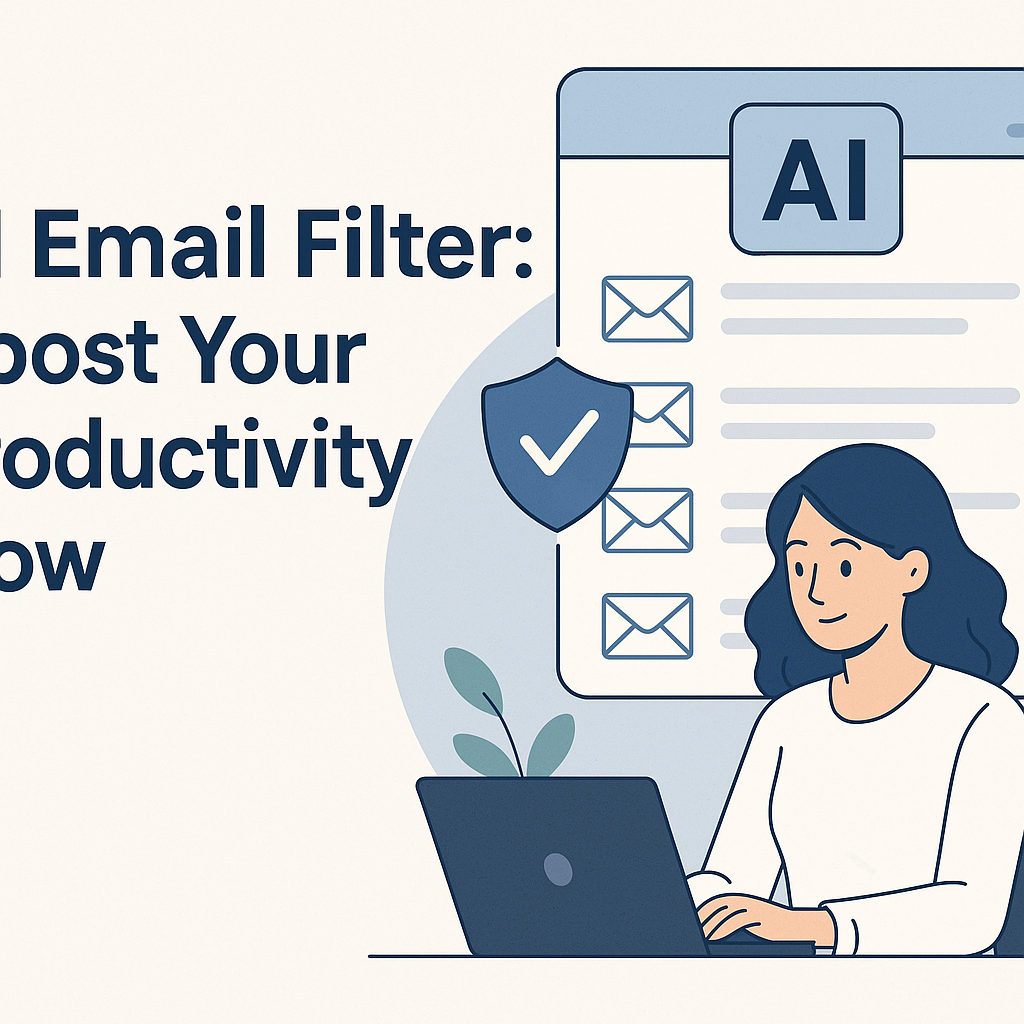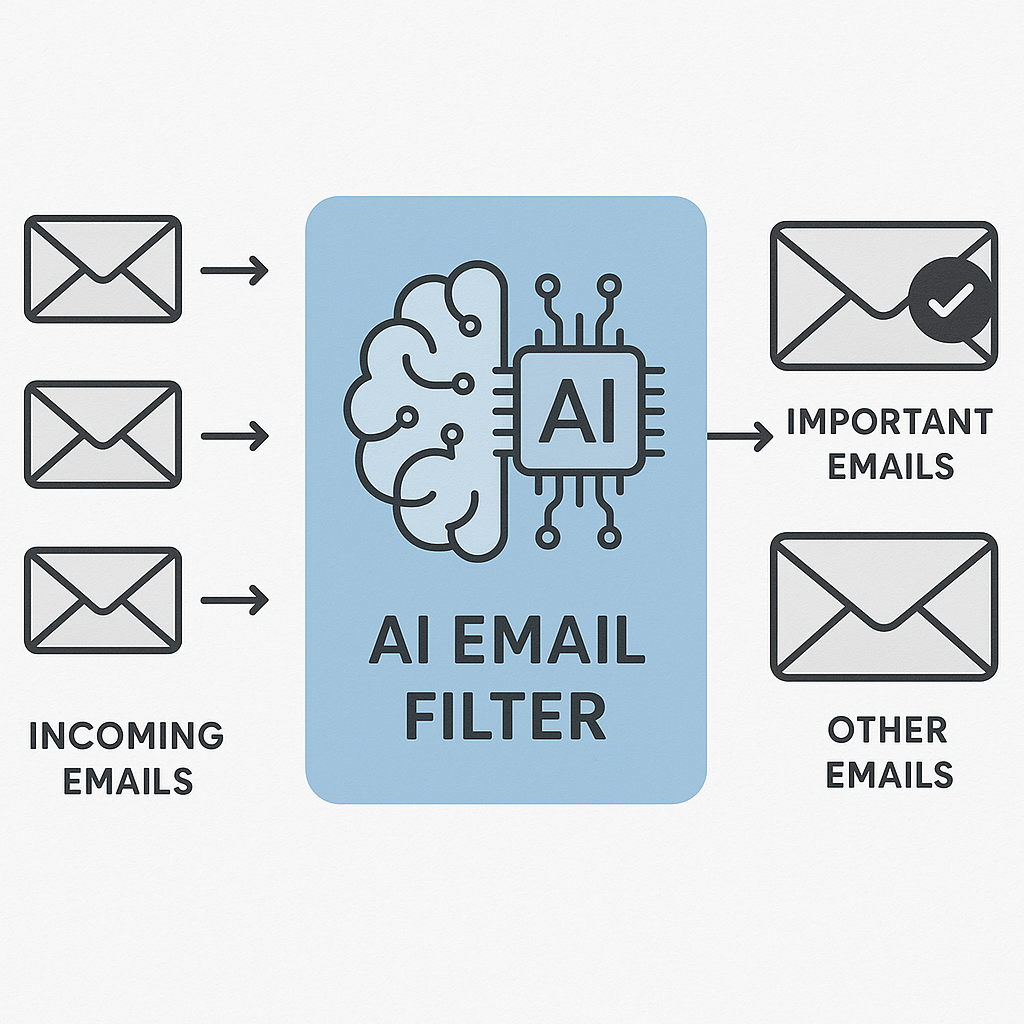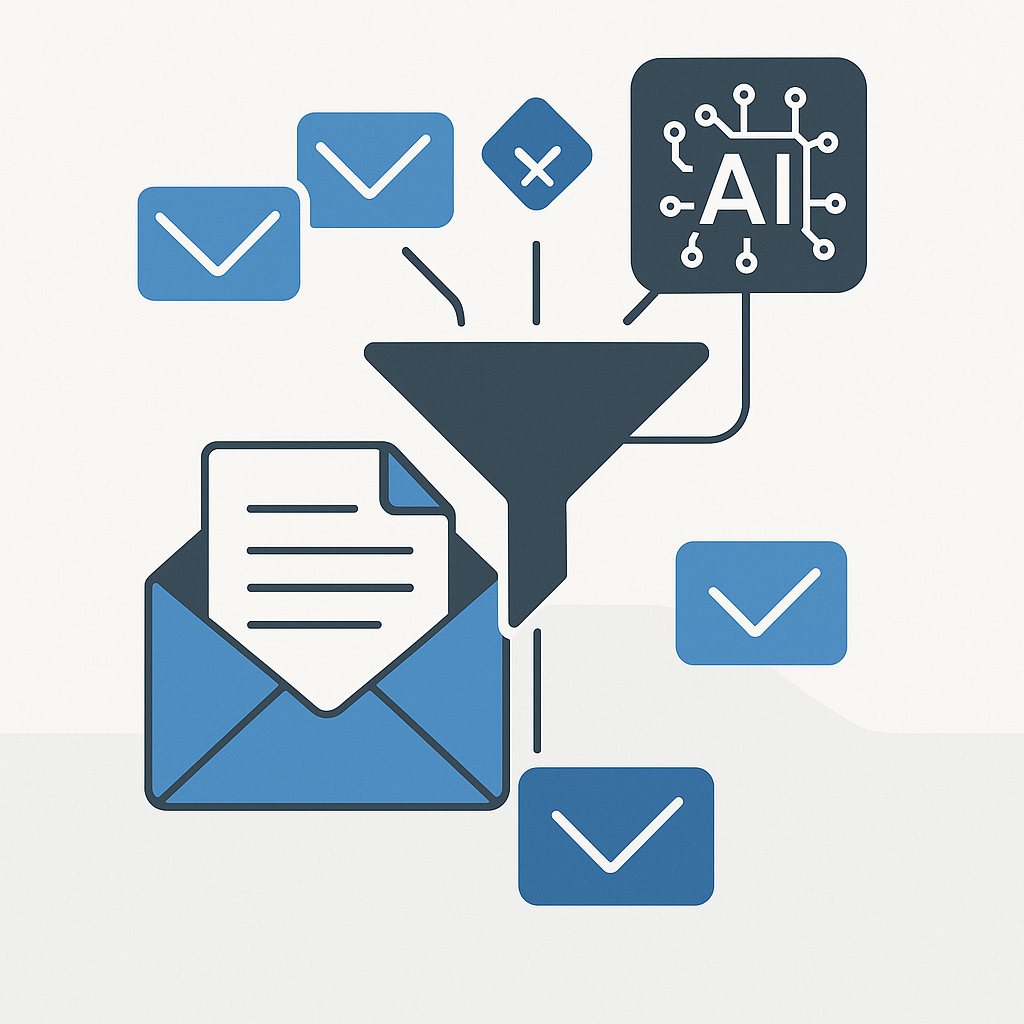AI Email Filter: Boost Your Productivity Now

In today's hyper-connected world, the inbox has become the digital battleground for professionals across every industry. We're bombarded daily with an unending stream of emails, from critical client communications and urgent team requests to marketing newsletters and automated notifications. For many, this constant influx leads to what feels like an inescapable cycle of email overload, draining precious time and mental energy. Executives, entrepreneurs, sales professionals, and remote workers alike struggle to keep pace, often finding themselves overwhelmed, missing vital information, or spending hours just sorting and prioritizing. But what if there was a smarter way to manage this digital deluge? Enter the ai email filter, a revolutionary technology poised to transform how we interact with our inboxes and, by extension, boost our overall productivity.
Understanding Traditional Email Filters vs. AI Email Filters
For decades, email filtering has relied on a relatively simple, rule-based system. You create rules like "if the sender is X, move to folder Y" or "if the subject contains Z, mark as read." While these traditional filters are effective for basic organization and spam detection, they have significant limitations in the face of modern email complexity.
Traditional filters are:
- Static: They require manual setup and constant tweaking. If a sender's email pattern changes, your rules might break.
- Keyword-dependent: They often miss context. An email might use a specific keyword but be low priority, or vice versa.
- Lack of intelligence: They can't understand nuance, sentiment, or the evolving importance of a sender or topic based on your current workload.
- Limited in scope: They primarily focus on moving emails, not on understanding their content or intent.
In contrast, AI email filters leverage advanced technologies like Machine Learning (ML) and Natural Language Processing (NLP) to offer a far more sophisticated approach to AI inbox management. These systems don't just follow rigid rules; they learn, adapt, and understand.
Key differences include:
- Dynamic & Adaptive: AI learns from your interactions. If you consistently mark certain types of emails as important or urgent, the AI will adapt its filtering and prioritization accordingly.
- Context-Aware: AI can analyze the content of an email, the sender's history, the urgency of the topic, and even your current schedule to determine priority.
- Intelligent Categorization: Beyond simple folders, AI can identify the intent behind an email (e.g., a request for information, a meeting proposal, a customer support issue) and categorize it appropriately.
- Predictive Capabilities: Some AI tools can predict which emails are likely to require a prompt response or which might be time-sensitive.
As one expert notes, AI email filters "push urgent and high-impact messages to the top, allowing quick action on what truly matters." (Superhuman Blog). This shift from manual rule-following to intelligent, context-aware processing is what makes AI email filters a game-changer for productivity.
How AI Email Filters Work: Categorization, Prioritization, and Smart Sorting
At their core, AI email filters operate by analyzing incoming messages using sophisticated algorithms. They process vast amounts of data – the email's content, sender information, recipient list, time sent, and your past interaction patterns – to make intelligent decisions about how to handle it. This process typically involves several key functions:
1. Intelligent Categorization
Instead of just basic folders, AI can automatically categorize emails based on their content and perceived intent. This goes beyond simple keywords. For example, an AI filter can distinguish between:
- Actionable items: Emails that require a specific task or response.
- Information/Updates: Emails that provide context or news but don't require immediate action.
- Meeting requests: Emails proposing or confirming appointments.
- Notifications: Automated alerts from systems or services.
- Promotional content: Marketing emails or newsletters.
This level of granular categorization helps in managing business email organization much more effectively, ensuring that related communications are grouped together.
2. Advanced Prioritization
This is perhaps the most impactful function. AI algorithms can assess the urgency and importance of an email by considering multiple factors:
- Sender Reputation/Importance: Is this from your CEO, a key client, or a known spammer? AI can learn who your important contacts are.
- Keywords and Sentiment: Words like "urgent," "deadline," "ASAP," or phrases indicating a problem can flag an email for higher priority. AI can also detect sentiment – a frustrated customer email might be prioritized over a casual update.
- Contextual Relevance: If you're working on a specific project, emails related to that project might be automatically elevated.
- Past Interactions: If you've had a lengthy or critical conversation with someone, subsequent emails from them might be given more weight.
This intelligent prioritization ensures that critical messages don't get buried, significantly improving response times and preventing missed opportunities. Many find that embracing smart email filtering dramatically cuts down on the time spent searching for important messages.
3. Smart Sorting and Summarization
Beyond just placing emails into folders, AI can perform more advanced sorting. It can:
- Group related threads: Consolidate lengthy email chains into a single, manageable view.
- Flag for Follow-up: Identify emails that require a future action or response.
- Summarize content: Some advanced tools can provide concise summaries of long emails or threads, allowing you to grasp the core message quickly.
This capability is a powerful component of AI inbox management, helping users to digest information more efficiently and take action faster.
4. Response Assistance and Automation
The most advanced AI email filters can even assist with drafting responses. Based on the email's content and your typical response style, AI can suggest replies, fill in standard information, or even draft entire emails for routine inquiries. This is a significant step towards automating repetitive email tasks and a key aspect of AI email task automation.
Key Benefits of Using AI Email Filters for Business Professionals
The adoption of AI email filters offers a cascade of benefits that directly translate into enhanced professional performance and well-being. For anyone looking to reduce email overload and reclaim their workday, these advantages are compelling:
- Boosted Productivity: By automating the tedious tasks of sorting, categorizing, and prioritizing, AI frees up significant amounts of time. Professionals can then dedicate more energy to high-value activities like strategic planning, client engagement, and creative problem-solving. This is a cornerstone of effective email workflow optimization.
- Improved Focus and Reduced Distractions: When your inbox is intelligently organized, you're less likely to be pulled away by non-urgent messages. AI filters can isolate critical communications, allowing you to enter a state of deep work without the constant interruption of a cluttered inbox.
- Faster Response Times: Prioritizing important emails means urgent requests are addressed promptly. For sales professionals, this can mean closing deals faster; for customer support, it means happier clients; for project managers, it means smoother operations.
- Reduced Stress and Mental Load: The sheer volume of unmanaged email can be a significant source of stress and anxiety. An AI-powered system that brings order to this chaos alleviates this burden, leading to a calmer and more focused professional mindset.
- Enhanced Organization and Information Retrieval: With emails intelligently categorized and prioritized, finding specific information becomes effortless. This improves collaboration, project management, and overall efficiency.
- Better Decision-Making: By surfacing the most relevant and urgent information quickly, AI filters empower professionals to make more informed and timely decisions.
- Streamlined Workflow for Specific Roles: For instance, AI for sales professionals can mean automatically flagging leads, prioritizing follow-ups based on engagement, and ensuring no prospect falls through the cracks.
A study or observation from platforms like Trimbox highlights that AI-powered filters can offer "greater convenience and customization," transforming the inbox into a "smarter, more organized space." (Trimbox Blog). These tools are not just about managing emails; they're about managing your time and attention more effectively.
Leveraging AI Email Filters: Practical Tips and Best Practices
Implementing AI email filters effectively requires a strategic approach. It's not just about turning on a feature; it’s about integrating it into your daily workflow. Here are actionable tips to maximize the benefits:
- Define Your Goals: Before diving in, clarify what you want to achieve. Do you want to reduce email overload, improve business email organization, or speed up client responses? Knowing your objectives will guide your choice of tools and settings.
- Start with Built-In Features: Many popular email clients already offer AI-powered capabilities. For example, Gmail's "Categories" (Primary, Social, Promotions, Updates, Forums) and Outlook's "Focused Inbox" use AI to sort emails. Explore and enable these first to get a feel for how AI can help. If you're a heavy Gmail user, understanding how to optimize your business email Gmail experience with these features is a great starting point.
- Train the AI: The power of AI lies in its learning capability. Be proactive in teaching it. When an email is miscategorized or wrongly prioritized, correct it. Mark emails as important or not important, move them to the correct folders, and archive them promptly. The more you interact, the smarter the AI becomes.
- Customize Where Necessary: While AI is intelligent, it's not infallible. Supplement AI filtering with custom rules for specific, recurring scenarios that the AI might not pick up on initially. For instance, if you always need to respond to a particular vendor within 24 hours, a specific rule might be beneficial.
- Integrate with Your Workflow: AI email filters are most powerful when connected to other productivity tools. If your AI can help identify email action items, ensure these are automatically pushed to your task management system. This creates a seamless workflow.
- Regularly Review and Refine: Periodically check how your AI filters are performing. Are you still missing important emails? Are low-priority items cluttering your main view? Adjust your settings or provide more training data as needed.
- Be Patient: AI systems learn over time. Don't expect perfection on day one. Give the AI a few weeks to adapt to your patterns and preferences. The initial investment in training will pay off significantly.
- Explore Dedicated AI Tools: For more advanced features like automated response drafting, email summarization, or sophisticated delegation, consider third-party AI productivity platforms. These tools can offer deeper levels of automation and intelligence.
As noted on GPT.space, "AI technologies are designed to learn from interactions and improve over time, making them ideal for managing repetitive tasks like sorting emails, prioritizing responses, and even drafting replies." (GPT.space Blog). By actively engaging with these tools, you harness their full potential.
Choosing the Right AI Email Filter Solution for Your Needs
The market offers a variety of solutions, ranging from integrated features within existing email clients to standalone AI-powered productivity platforms. Selecting the right one depends on your specific needs, budget, and technical comfort level.
1. Integrated Email Client Features
Pros: Already part of your existing workflow, usually free or included with your subscription, easy to start using. Cons: May offer less advanced customization or fewer specialized features compared to dedicated tools. Examples: Gmail's categories, Outlook's Focused Inbox.
2. Dedicated AI Email Productivity Tools
These are specialized applications designed to enhance email management. They often offer a broader suite of features, including advanced filtering, AI-driven summarization, automated follow-ups, and more. When looking for comprehensive support, consider leveraging tools like an ai executive assistant to manage your email communications, freeing up valuable cognitive load for strategic tasks. These platforms are built to help you truly master your inbox and boost your efficiency.
Pros: Advanced AI capabilities, deeper customization, potential for integration with other business tools, comprehensive inbox management. Cons: May involve a subscription cost, could have a steeper learning curve, requires integration with your existing email provider.
3. AI Assistants and Automation Platforms
Some tools focus on specific aspects of email productivity, such as extracting key information from messages (see Email Text Extraction) or automating certain tasks (like AI Email Task Automation). Others specialize in identifying and organizing action items within your emails (like Email Action Items) or even intelligent delegation (see AI Email Delegate and Smart Email Delegation).
Key Considerations When Choosing:
- Features: Does it offer the specific AI capabilities you need (prioritization, categorization, summarization, drafting)?
- Integration: Does it work seamlessly with your current email client (e.g., Gmail, Outlook) and other essential business applications?
- Ease of Use: Is the interface intuitive? How much effort is required to set up and train the AI?
- Security and Privacy: How does the tool handle your sensitive email data? Ensure it meets your organization's security standards.
- Cost: Evaluate the pricing model against the benefits it provides. Many offer free trials, which are excellent for testing.
Ultimately, the best solution is one that fits your specific workflow and helps you achieve your goals for better email productivity tools and overall AI inbox management.
Beyond Filtering: Other AI Tools for Email Productivity
While AI email filters are powerful, they are just one piece of the puzzle for achieving peak email productivity. Artificial intelligence is revolutionizing many other aspects of email management, offering complementary tools that can further streamline your workflow:
- AI Email Assistants: These tools go beyond filtering to help you write, summarize, and manage your communications. Some can even schedule meetings or draft responses based on simple prompts.
- Email Text Extraction: Tools that can intelligently pull out key information from emails – like dates, times, addresses, or specific data points – can save immense time on manual data entry. This is crucial for tasks involving Email Text Extraction.
- AI Email Task Automation: This involves using AI to automate repetitive email-related tasks, such as sending follow-up emails, updating CRM records based on email content, or sending out standard reports. This is a core component of AI Email Task Automation.
- Email Action Item Identification: AI can scan your emails to identify specific tasks or action items you need to complete, helping you stay on top of your responsibilities. This directly supports mastering your inbox productivity through Email Action Items.
- AI-Powered Delegation: Advanced AI can even help delegate tasks based on email content to team members, ensuring work is distributed efficiently. This falls under the umbrella of AI Email Delegate and Smart Email Delegation.
- Meeting Intelligence: Tools like the Fireflies.ai Note Taker can record, transcribe, and summarize meetings. Often, action items or key decisions from these meetings need to be communicated via email, making this a valuable complementary tool for boosting overall communication efficiency. This relates to Fireflies.ai Note Taker.
- Enhanced Client Integration: For those heavily reliant on platforms like Gmail, understanding how to leverage AI within your specific client ecosystem can unlock significant advantages. This includes optimizing your Business Email Gmail usage and exploring the Best Email Client for Gmail that integrates AI effectively.
- Email Reputation Management: While not a direct AI filtering tool, an organized inbox and efficient email practices can indirectly contribute to better email deliverability and reputation, which is increasingly important in the AI era. Understanding Email Reputation is a broader aspect of email communication strategy.
By combining AI email filters with these other AI-powered tools, professionals can create a truly optimized and intelligent email ecosystem. As Cameron White suggests on LinkedIn, AI offers "practical ways to boost your team's efficiency" beyond just basic filtering. (LinkedIn).
Conclusion: Embracing AI for a More Productive Email Workflow
The daily battle against inbox overload is a drain on productivity, focus, and well-being for professionals everywhere. Traditional filtering methods, while useful, are no longer sufficient to manage the volume and complexity of modern communication. The advent of the ai email filter represents a paradigm shift, offering intelligent, adaptive, and context-aware solutions to bring order to the chaos.
By understanding how AI categorizes, prioritizes, and sorts your emails, you can begin to leverage these powerful tools to your advantage. The benefits are clear: increased productivity, improved focus, faster response times, and a significant reduction in stress. Whether you start with the built-in AI features of your existing email client or explore dedicated AI productivity platforms, the key is to actively engage with and train these systems.
Embracing AI in your email workflow is not just about staying current; it's about empowering yourself to reclaim your time and mental energy. It’s about moving from being a passive recipient of emails to an active manager of your communication, focusing on what truly drives your business forward. By integrating AI email filters and related tools, you align yourself with broader AI-Augmented Productivity Frameworks, ensuring you're equipped for the future of work.
Don't let your inbox dictate your day any longer. Start exploring AI solutions today and experience the transformation of your email workflow, paving the way for greater efficiency and success.



